- CLASSIC MAGAZINES
- REVIEW CREW
A show recapping what critics thought back
when classic games first came out! - NEXT GENERATION'S BEST & WORST
From the worst 1-star reviews to the best
5-stars can offer, this is Next Generation! - NINTENDO POWER (ARCHIVE)
Experience a variety of shows looking at the
often baffling history of Nintendo Power! - MAGAZINE RETROSPECTIVE
We're looking at the absolutely true history of
some of the most iconic game magazines ever! - SUPER PLAY'S TOP 600
The longest and most ambitious Super NES
countdown on the internet! - THEY SAID WHAT?
Debunking predictions and gossip found
in classic video game magazines! - NEXT GENERATION UNCOVERED
Cyril is back in this spin-off series, featuring the
cover critic review the art of Next Generation! - HARDCORE GAMER MAGAZING (PDF ISSUES)
Download all 36 issues of Hardcore Gamer
Magazine and relive the fun in PDF form!
- REVIEW CREW
- ELECTRONIC GAMING MONTHLY
- ELECTRONIC GAMING MONTHLY RANKS
From Mario to Sonic to Street Fighter, EGM
ranks classic game franchises and consoles! - ELECTRONIC GAMING MONTHLY BEST & WORST
Counting down EGM’s best and worst reviews
going year by year, from 1989 – 2009! - ELECTRONIC GAMING BEST & WORST AWARDS
11-part video series chronicling the ups and
downs of EGM’s Best & Worst Awards!
- ELECTRONIC GAMING MONTHLY RANKS
- GAME HISTORY
- GAME OVER: STORY BREAKDOWNS
Long-running series breaking down game
stories and analyzing their endings! - A BRIEF HISTORY OF GAMING w/ [NAME HERE]
Real history presented in a fun and pithy
format from a variety of game historians! - THE BLACK SHEEP
A series looking back at the black sheep
entries in popular game franchises! - INSTANT EXPERT
Everything you could possibly want to know
about a wide variety of gaming topics! - FREEZE FRAME
When something familiar happens in the games
industry, we're there to take a picture! - I'VE GOT YOUR NUMBER
Learn real video game history through a series
of number-themed episodes, starting at zero! - GREAT MOMENTS IN BAD ACTING
A joyous celebration of some of gaming's
absolute worst voice acting!
- GAME OVER: STORY BREAKDOWNS
- POPULAR SHOWS
- DG NEWS w/ LORNE RISELEY
Newsman Lorne Riseley hosts a regular
series looking at the hottest gaming news! - REVIEW REWIND
Cyril replays a game he reviewed 10+ years
ago to see if he got it right or wrong! - ON-RUNNING FEUDS
Defunct Games' longest-running show, with
editorials, observations and other fun oddities! - DEFUNCT GAMES QUIZ (ARCHIVE)
From online quizzes to game shows, we're
putting your video game knowledge to the test!- QUIZ: ONLINE PASS
Take a weekly quiz to see how well you know
the news and current gaming events! - QUIZ: KNOW THE GAME
One-on-one quiz show where contestants
find out if they actually know classic games! - QUIZ: THE LEADERBOARD
Can you guess the game based on the classic
review? Find out with The Leaderboard!
- QUIZ: ONLINE PASS
- DEFUNCT GAMES VS.
Cyril and the Defunct Games staff isn't afraid
to choose their favorite games and more! - CYRIL READS WORLDS OF POWER
Defunct Games recreates classic game
novelizations through the audio book format!
- DG NEWS w/ LORNE RISELEY
- COMEDY
- GAME EXPECTANCY
How long will your favorite hero live? We crunch
the numbers in this series about dying! - VIDEO GAME ADVICE
Famous game characters answer real personal
advice questions with a humorous slant! - FAKE GAMES: GUERILLA SCRAPBOOK
A long-running series about fake games and
the people who love them (covers included)! - WORST GAME EVER
A contest that attempts to create the worst
video game ever made, complete with covers! - LEVEL 1 STORIES
Literature based on the first stages of some
of your favorite classic video games! - THE COVER CRITIC
One of Defunct Games' earliest shows, Cover
Critic digs up some of the worst box art ever! - COMMERCIAL BREAK
Take a trip through some of the best and
worst video game advertisements of all time! - COMIC BOOK MODS
You've never seen comics like this before.
A curious mix of rewritten video game comics!
- GAME EXPECTANCY
- SERIES ARCHIVE
- NINTENDO SWITCH ONLINE ARCHIVE
A regularly-updated list of every Nintendo
Switch Online release, plus links to review! - PLAYSTATION PLUS CLASSIC ARCHIVE
A comprehensive list of every PlayStation
Plus classic release, including links! - RETRO-BIT PUBLISHING ARCHIVE
A regularly-updated list of every Retro-Bit
game released! - REVIEW MARATHONS w/ ADAM WALLACE
Join critic Adam Wallace as he takes us on a
classic review marathon with different themes!- DEFUNCT GAMES GOLF CLUB
Adam Wallace takes to the links to slice his way
through 72 classic golf game reviews! - 007 IN PIXELS
Adam Wallace takes on the world's greatest spy
as he reviews 15 weeks of James Bond games! - A SALUTE TO VAMPIRES
Adam Wallace is sinking his teeth into a series
covering Castlevania, BloodRayne and more! - CAPCOM'S CURSE
Adam Wallace is celebrating 13 days of Halloween
with a line-up of Capcom's scariest games! - THE FALL OF SUPERMAN
Adam Wallace is a man of steel for playing
some of the absolute worst Superman games! - THE 31 GAMES OF HALLOWEEN
Adam Wallace spends every day of October afraid
as he reviews some of the scariest games ever! - 12 WEEKS OF STAR TREK
Adam Wallace boldly goes where no critic has
gone before in this Star Trek marathon!
- DEFUNCT GAMES GOLF CLUB
- DAYS OF CHRISTMAS (ARCHIVE)
Annual holiday series with themed-episodes
that date all the way back to 2001!- 2015: 30 Ridiculous Retro Rumors
- 2014: 29 Magazines of Christmas
- 2013: 29 Questionable Power-Ups of Christmas
- 2012: 34 Theme Songs of Christmas
- 2011: 32 Game Endings of Christmas
- 2010: 31 Bonus Levels of Christmas
- 2009: 30 Genres of Christmas
- 2008: 29 Controls of Christmas
- 2007: 34 Cliches of Christmas
- 2006: 33 Consoles of Christmas
- 2005: 32 Articles of Christmas
- 2004: 31 Websites of Christmas
- 2003: 29 Issues of Christmas
- 2002: 28 Years of Christmas
- 2001: 33 Days of Christmas
- NINTENDO SWITCH ONLINE ARCHIVE
- REVIEW ARCHIVE
- FULL ARCHIVE
Marvel vs. Capcom Origins
Back when the original Marvel vs. Capcom fist hit arcades, Sam Raimi was years away from rebooting Spider-Man, Bryan Singer's X-Men was merely in the planning stages and Joss Whedon was too busy helming Buffy the Vampire Slayer to even consider writing and directing The Avengers. It was a point in time before Marvel had really broken out into the mainstream media; a time before everybody and their grandmothers knew that Tony Stark was Iron Man.
It's hard to believe that so much has changed in the last fourteen years. Thanks to a steady string of top grossing superhero movies, popular video games, an expensive Broadway musical and television shows, Marvel can finally say that they are the comic book kings of all media. Marvel vs. Capcom Origins for the Xbox Live Arcade and PlayStation Network takes us back to a time before all the mainstream success; back to a time when Iron Man and Thor were just B-tier heroes.
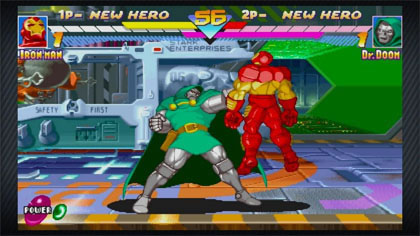
Marvel vs. Capcom Origins is an endlessly addictive compilation featuring two Capcom arcade hits. As the title suggests, the first game is none other than Marvel vs. Capcom. For the first time ever, fans of both Vega and Wolverine will be able to own all three Marvel vs. Capcom installments on one home console. Along for the ride is Marvel Super Heroes, the 1995 arcade hit that helped lay a lot of the fundamentals that would later be used in Capcom's versus series.
Of course, neither of these games are the real origins of Marvel vs. Capcom. For that you would need to go back to X-Men: Children of the Atom in 1994. Also missing is X-Men vs. Street Fighter and Marvel Super Heroes vs. Street Fighter, two arcade hits that would have fit in perfectly next to the original Marvel vs. Capcom. While purists might grumble about the selection, the two games in the package are the best of the bunch. Although the subject matter is the same, their differences help complement the other.
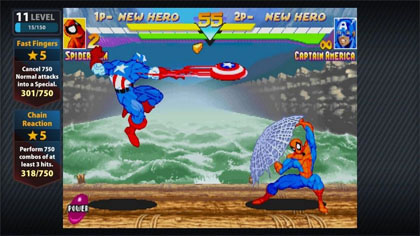
Compared to Marvel vs. Capcom 2's staggering 56 playable characters, the first installment is downright quaint. There are 22 characters in total, evenly spread out between Marvel and Capcom. You get the usual suspects, including Ryu, Chun Li, Zangief and Morrigan on Capcom's side, and Wolverine, Hulk, Iron Man and Captain America over at Marvel.
Capcom could have stopped right there and everybody would have been happy, but they took the extra step needed to make this 1998 tag team fighter truly special. You don't just get the regular characters; you also get brawlers pulled from the archive. Strider's Hiryu makes a surprise appearance, as does Captain Commando. Mega Man and Roll bring some pint-sized power, and Gambit wins a spot over a whole host of more popular X-Men characters. This is a delightful cast that is fun to pair up.
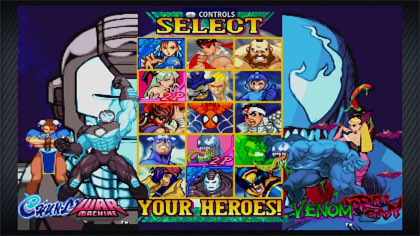
Unlike Marvel vs. Capcom 2, this game is only two-on-two. You can bring out a third computer-controlled helper from time to time, but you will only ever select two different fighters. Considering how frantic and crazy the sequels became, the slower pace of the original is a welcome treat. While all kinds of chaotic special moves happen throughout the round, I almost always had enough time to plan ahead. Learning each character is also easier when there are only 22 to choose from.
On the other side of the collection sits Marvel Super Heroes, a one-on-one fighter starring twelve of your favorite comic book characters. Capcom effortlessly brings together X-Men characters (Wolverine, Magneto, Psylocke), assembled Avengers (Captain America, Iron Man, The Incredible Hulk) and convinces Spider-Man to take part in this blockbuster fighting game.
Looking back at it now, it's clear that Capcom was using these games as a sounding board for their different ideas. Marvel Super Heroes introduces a number of weird concepts that never made it into Marvel vs. Capcom. For one thing, much of the fighting revolves around these little orbs that get beaten out of your opponent. These orbs allow players to power-ups their character, earn life, speed up and more. It's a unique gimmick that makes this 1995 arcade hit feel more like Capcom's Power Stone than a Street Fighter game.
While a game like Marvel Super Heroes vs. Street Fighter might have made more sense in this compilation, it's nice to see the comic book giant get a release that isn't crowded with Ryu and Ken cameos. And because it's a one-on-one fighting game, it feels substantially different from the more frantic tag team action of Marvel vs. Capcom. This is a great change of pace that offers its own set of exciting moments and secrets to uncover.
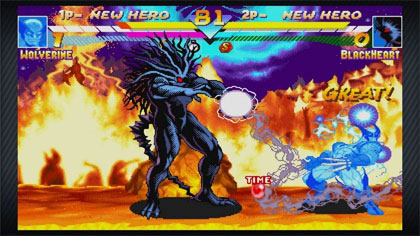
Despite being well over a decade old, both games have held up extremely well. Of course, much of that comes down to the know-how of everybody involved. By 1995, Capcom had all but mastered the art of making 2D fighting games. The result is incredibly polished arcade titles with top notch visuals and a good sense of depth. Both games feature impressive boss battles, character endings and colorful backgrounds that change as the fight roars on. The artwork looks like it was pulled out of the pages of a Marvel comic book, which is the highest praise you could possibly give this style of game.
Just to add another level of authenticity, Capcom has added a filter that approximates the look of the original arcade cabinet. With its rounded corners and lines of resolution, it's uncanny how similar it looks. Not feeling nostalgic? Don't worry, you can shut off the filtering and make the display full screen. Or, just for fun, you can play the game from over the shoulder of somebody else.
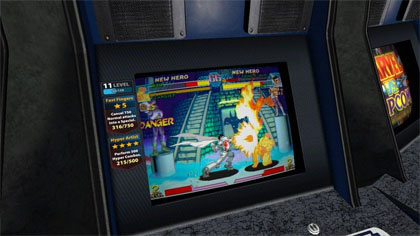
Much like Street Fighter III: Third Strike Online Edition released last year, Marvel vs. Capcom Origins features a list of goals to complete while battling opponents. Many are as basic as throw a certain amount of projectiles, while others require users to perform lengthy combo moves. Many of the goals will be completed by simply playing through the arcade mode a few times, but there are a few that will take some real doing to accomplish.
Even if this is nothing more than a way to count up how many times you throw an enemy or land a three-hit combo, it's fun to have something to work towards while grinding through the same batch of characters one after another. Completing these goals also gives you points, which in turn are used to buy hidden characters, costumes, music and concept art.

Both games offer online modes, though neither is especially fleshed out. I found it easy to get into a game and have a good, lag-free time. Unfortunately, this is not a series that is welcoming to new players. Both games are full of exploits that series veterans will use to end the round as quickly as possible. Thankfully the offline mode is compelling enough to keep you playing until you finally stand a chance to defeat Sheng Long ... or, at the very least, Thanos.
Marvel vs. Capcom Origins may not have as many modes as newer fighting games, but these two games more than justify the fifteen dollar asking price. The goals are also a lot of fun to complete, forcing you to try characters and moves you might otherwise skip. Regardless of whether you're brave enough to face the online competition or not, you'll get your money's worth with Marvel vs. Capcom Origins.
HOME |
CONTACT |
NOW HIRING |
WHAT IS DEFUNCT GAMES? |
NINTENDO SWITCH ONLINE |
RETRO-BIT PUBLISHING
Retro-Bit |
Switch Planet |
The Halcyon Show |
Same Name, Different Game |
Dragnix |
Press the Buttons
Game Zone Online | Hardcore Gamer | The Dreamcast Junkyard | Video Game Blogger
Dr Strife | Games For Lunch | Mondo Cool Cast | Boxed Pixels | Sega CD Universe | Gaming Trend
Game Zone Online | Hardcore Gamer | The Dreamcast Junkyard | Video Game Blogger
Dr Strife | Games For Lunch | Mondo Cool Cast | Boxed Pixels | Sega CD Universe | Gaming Trend
Copyright © 2001-2025 Defunct Games
All rights reserved. All trademarks are properties of their respective owners.
All rights reserved. All trademarks are properties of their respective owners.





























